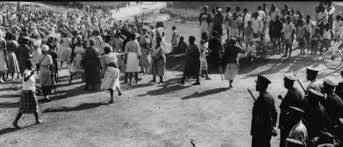Aba Women’s Riot: A Fight Against Colonial Power

In the year 1929, in the southeastern region of Nigeria, an event that would leave a lasting mark on history took place. This event, known as the Aba Women’s Riot, was a protest led by thousands of Igbo and Ibibio women against the harsh and unjust policies of British colonial rule. The revolt, which occurred between November and December of that year, stood as a significant moment in the history of resistance against colonialism in Africa. It demonstrated the strength and resolve of the local women, who the British authorities had underestimated. The uprising had far-reaching consequences, not only for the colonial government but also for the communities involved.
A Colonial Decision Sparks Unrest
The roots of the Aba Women’s Riot can be traced to the British colonial government's decision to impose direct taxation on the local population. For years, the British had controlled southeastern Nigeria through a system known as “indirect rule,” where local chiefs and warrant officers were used to carry out orders from the colonial administrators. This system had disrupted traditional power structures, particularly in Igbo society, where leadership had previously been more decentralized.
A decision was made by the British authorities to extend taxation to women, who had previously been exempt. This plan, coupled with the abuses of the warrant chiefs—who were often corrupt and unaccountable—created widespread dissatisfaction. The women, who managed marketplaces and played key roles in their communities, feared they would be taxed on their livelihoods. Rumors spread quickly, and it was believed that the British intended to count every household’s women and livestock as a means to enforce these taxes.
In response, meetings were held by women in various villages, and it was decided that action needed to be taken to resist these policies. Word spread across the region, and soon, thousands of women from Igbo and Ibibio communities were mobilized. What began as a local protest soon turned into a full-scale revolt against colonial authority.
The Revolt Gains Strength
The first major action took place in the town of Oloko, where the women confronted one of the warrant chiefs who had been accused of misconduct. Led by women such as Nwanyeruwa, who was considered a key figure in sparking the uprising, they demanded that the chief step down and that the plans for taxation be abandoned. The women sang traditional songs, danced, and chanted as a way to show their displeasure, a form of protest deeply rooted in their culture. This strategy was effective because it combined their social influence with a show of unity and determination.
Over the following weeks, the protests spread to other towns and villages. Women gathered at government offices, markets, and other public places, blocking roads and disrupting trade. In many cases, the protests remained non-violent, but tensions escalated as the women faced resistance from colonial authorities. In some instances, buildings were destroyed, and violence broke out. The colonial government, unprepared for such a large-scale protest, responded with force. British soldiers were deployed, and many women were arrested. Sadly, in several confrontations, lives were lost as the authorities attempted to suppress the uprising.
In total, over 25,000 women participated in the protests, which covered a wide area across southeastern Nigeria. The Aba Women’s Riot, or “Women’s War” as it was sometimes called, was notable not only for its scale but also for the methods used by the women. Their protests involved chanting, singing, and dancing, drawing from their traditional roles in society while expressing their anger in a way that was difficult to ignore.
Long-Term Impact on Nigeria and Colonial Rule
The immediate outcome of the protests was a significant shift in British colonial policy. The proposed taxation of women was never implemented, and the warrant chief system, which had been at the heart of the unrest, was reformed. Many corrupt chiefs were removed from power, and the colonial government was forced to take a more measured approach in its dealings with local communities. The riot had shown that the people, especially the women, would not passively accept the oppressive rule, and this realization led to a reduction in the powers given to warrant chiefs.
However, the impact of the Aba Women’s Riot extended beyond the immediate changes to colonial administration. It became an important symbol of resistance, showing that ordinary people—especially women—could successfully challenge injustice. The riot inspired future generations of activists in Nigeria and across Africa, contributing to the broader movements for independence that would gain momentum in the decades that followed.
For the women themselves, the revolt strengthened their roles within their communities. They had successfully stood up not only to colonial rule but also to the men who had benefited from the warrant chief system. Their courage and organizational skills were recognized, and in the years that followed, women’s influence in political and economic matters grew. The legacy of the Aba Women’s Riot has remained a source of pride, especially in southeastern Nigeria, where it is remembered as a defining moment in the fight for justice and equality.
Till today, the story of the Aba Women’s Riot continues to be told as a reminder of the power of collective action and the importance of standing up against injustice. The sacrifices made by those women, many of whom risked their lives, are honored and remembered as an integral part of the country’s history.
The Aba Women’s Riot of 1929 was a powerful example of how ordinary people can drive change. Through their determination and unity, the women of southeastern Nigeria forced the colonial government to reconsider its policies and reform a system that had brought hardship to their communities. Their legacy continues to inspire movements for justice and equality, serving as a reminder that even in the face of great adversity, resistance is possible.





